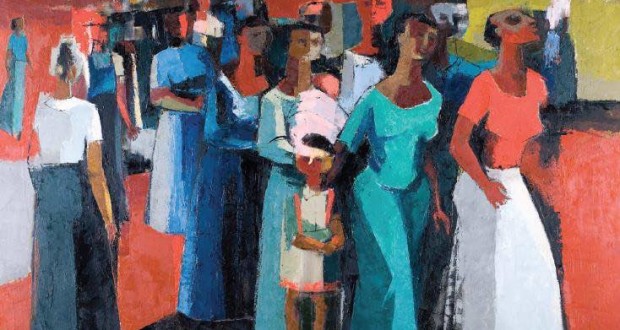“I am so perfect, so divine, so ethereal, so surreal, I cannot be comprehended except by my permission…” – Nikki Giovanni, poetess featured in Legacies
Legacies is a liberating read, one that will leave young women feeling empowered to reach for their purpose in life armed with the knowledge that some of the greatest leaders in history were black women. Legaciesgives young women who are of African descent permission to see themselves as they truly are – descendants of kings and queens who were mighty warriors, inventors, and world changers.
Book cover with “Girl In A Red Dress” by Laura Wheeler Waring
In Legacies: A Guide for Young Black Women in Planning Their Future, written by Constance Gipson and Hazel Mahone, Ed. D., 16 African Queens, and nearly 40 contemporary African-American women are beautifully portrayed alongside artwork and poetry to help young women on their journey to self-realization. Major themes run deep, including: the ideology that a young woman can’t confidently move forward without having a clear understanding of her past; that low self-esteem has a direct correlation to how a person’s legacy and heritage are presented; and, how not seeing proper and accurate images can leave a young woman voiceless. The legacy of female African descendants is communicated to modern-day African-American young women in such a manner that one is immediately inspired to reach even higher in politics, education, in areas of self-love and in having a greater influence globally on perspectives of blackness.
Female warriors, queens, and revolutionaries from the “past,” reveal themselves supernaturally, reminding and awakening young women coming of age in the present about their ancestral past and personal heritages. Highlighted are the accomplishments of 40 current professional women. Cecilia E. Rouse and Carolyn Rouse, sisters whose dad was the first African-American in the United States to receive a PhD in physics, and whose mother has a masters in anthropology, discuss how their parents’ education inspired their three daughters to receive PhDs from Ivy League schools and empowered them to become change-makers in their fields of choice. This influence from one generation to the next is critical. Education brings options and Legacies encourages young women to take advantage of the whatever educational opportunities are available to them. Workbooks within Legacies can be shared with daughters and young women in mentor groups allowing them to write out dietary, educational, and short and long term life-goals.

The Black Virgin given in the Chadaraita given by Louis XI
Legacies dismisses the perceptions of blackness prevalent in Westernized countries. Images and sculptures of the Virgin Mary in places like Paris, Montserrat and Guadalupe depict her as black. In fact, around the world there are 450 Black Virgin Marys, these include “The Black Virgin Mary in the Chadaraita” given by Louis XI (1323-83). Throughout chapters, art is intermingled with poetry, including Nikki Giovanni’s “Ego-Tripping,” Langston Hughes’s “When Sue Wears Red,” and Gwendolyn Bennett’s “To A Dark Girl.”
Africa’s size is emphasized with a map comparing it to the other continents, an image that brings home that size equals power. The reader learns about black women in history whose impact was great. These include: Queen Hatshepsut, descendant of Queen Nofretari; Queen Amanirenas,of the black Nubians who ruled Egypt; Queen Tiye, of the black Zanj people of Iraq and Iran; Taitu Bethel, an Ethiopian royal; as well as historical and biblical accounts of the Queen of Sheba who traveled to acquire wisdom at the feet of King Solomon.

“Blessed O Folks” by Leo Carty
Legacies is comprehensive and timely, underlining that the truest depiction of history comes from the source. There is nothing more misleading, even dangerous, than history that is told from the perspective of the rulers and those who colonized blacks down through history. The past should be told with honesty and truth.
A note from the authors is inspirational: “You carry within you the heritage of those who crossed deserts, savannahs, villages and oceans under horrific conditions. You are the legacies of people who survived the Middle Passage and came to the United States of America before waves of immigrants came to American shores. Others of you had ancestors who came later from Africa, Europe, or the Caribbean Islands. Whether the slave ship stopped in Barbados, Cape Verde, Trinidad or South Carolina, you are the daughters of Africa. It is a heritage that includes resilience, fortitude and perseverance that enabled the ancestors to survive the slave coffles from the North to the South and the humiliation of Jim Crow.”
Opening: “Walking” by Charles Alston
Legacies: A Guide For Young Black Women in Planning Their Future
Constance Gipson and Hazel Mahone, Ed.D
This article first appeared on February, 2016 here.



Recent Comments